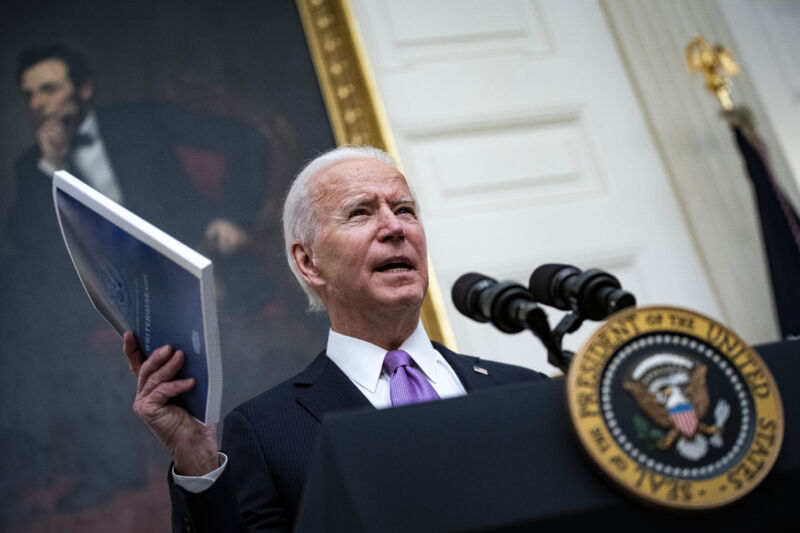Hit the ground running
—
Biden Administration starts off with a flurry of orders, actions, and comprehensive plan.
Beth Mole
–

Enlarge / US President Joe Biden releases his strategic COVID-19 plan at the White House on Thursday, Jan. 21, 2021.
Just a day into office, President Joe Biden and his administration have unveiled a comprehensive, 200-page strategic plan and over a dozen executive orders and actions to tackle the COVID-19 pandemic currently rampaging across the country.
With the running start, the administration hopes to finally get control over the virus, which has already taken the lives of more than 408,000 Americans. The number of deaths is expected to top 500,000 next month, Biden said in an appearance Thursday to unveil his strategic plan.
“Things are going to continue to get worse before they get better,” he said, calling his approach to the pandemic a “full-scale wartime effort.”
Square one
The lag between people becoming infected, developing COVID-19, and succumbing to the disease will keep the numbers grim for weeks to come, regardless of new efforts put in place today. But the administration says it’s also facing challenges from inheriting the work from the previous administration.
In remarks Thursday, Biden criticized the federal response so far: “For the past year, we couldn’t rely on the federal government to act with the urgency and focus and coordination that we needed, and we have seen the tragic cost of that failure.”
Upon taking office, sources in the administration told CNN that they were shocked by the state of the federal work on the pandemic—or the lack thereof. “There is nothing for us to rework,” one source told the outlet. “We are going to have to build everything from scratch.”
Another source echoed that the Trump administration had no plan and that Biden’s administration would have to start from “square one.” Upon realizing the situation, the administration member reportedly responded: “Wow, just further affirmation of complete incompetence.”
To get control of the pandemic, Biden moved ahead with a series of actions, signing executive orders Wednesday requiring masking and physical distancing on federal properties and organizing a White House COVID-19 response team. Thursday, he revealed 10 additional executive orders, which aim to: boost manufacturing for vaccine supplies and equipment; reimburse states for emergency supplies and National Guard deployments; increase testing capacity; support the development of new therapies; boost health data collection; guide schools on how to safely reopen; guide businesses on how to keep employees safe; require masking on transit and negative tests from international travelers; ensure and equitable pandemic response; and restore America’s leadership in public health on the global stage.
Plans in motion
The 200-page strategic plan, titled “National Strategy for the Covid-19 Response and Pandemic Preparedness,” fleshes out all the steps Biden has planned to tackle the pandemic. Chief among the priorities is to speed up vaccination, which has been plagued by disorganization since rollout began in December. So far, the federal government has distributed nearly 38 million doses, but only 17.5 million doses have gone into people’s arms and only about 2.4 million people have received their second dose. Biden has set a goal of administering 100 million vaccines in his first 100 days in office.
To reach that goal, Biden aims to speed vaccine development, make the vaccine available to more people, increase the number of places people can get vaccinated, and expand the medical workforce that can administer vaccines. He has already authorized the Federal Emergency Management Agency to begin setting up the first of many federal vaccination sites.
One of the biggest vaccination hurdles so far appears to have been coordination between states and the federal government. In his final days at the helm, former Health and Human Services Secretary, Alex Azar, laid the blame solely on states for the bungled rollouts. States, meanwhile, pointed fingers at the federal response.
To address the problem, Biden noted in his remarks Thursday that he has directed FEMA to assign a “COVID response liaison” for each state, so that every state will have its own federal point person to coordinate federal and state efforts to distribute vaccine and get shots into people’s arms.
Meanwhile, Biden also took steps to rejoin the World Health Organization, retracting withdrawal notification sent by the Trump administration. In an address Thursday, top infectious disease expert Anthony Fauci told the WHO board: “The United States stands ready to work in partnership and solidarity to support the international COVID-19 response, mitigate its impact on the world, strengthen our institutions, advance epidemic preparedness for the future, and improve the health and wellbeing of all people throughout the world.”

